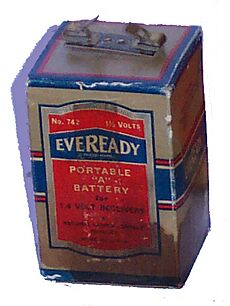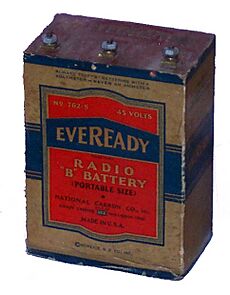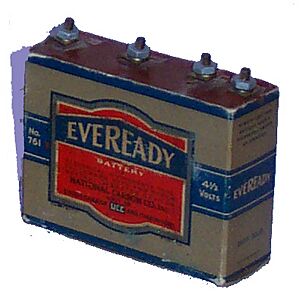Vacuum tube battery facts for kids

Imagine a time before modern electronics, when radios were big boxes that used special glass tubes called electronic tubes (or valves in some places). These early radios needed different types of power to work. Instead of plugging into a wall outlet, they often ran on several batteries. Each battery was given a special letter – "A", "B", or "C" – depending on which part of the electronic tube it powered.
When these tubes were first invented, they had two main parts: a filament (which heated up) and a plate (which collected electrons). The battery that powered the filament was called the "A" battery. The battery that powered the plate was called the "B" battery. Later, a third part, called a control grid, was added to make the tubes even better. This new part needed its own power, so it was given the "C" battery. These names for batteries were mostly used in North America. Other countries sometimes used different names.
Contents
Powering Early Radios: A, B, and C Batteries
The "A" Battery: Heating Things Up
The "A" battery was essential because it powered the filament inside the electronic tube. Think of the filament like a tiny light bulb or heater. It needed to get hot for the tube to work properly.
Because the filament used a lot of electricity, the "A" battery drained quite quickly. People often used rechargeable batteries for this purpose, like the kind found in cars today, which were sometimes called "wet batteries." This meant they could be recharged instead of constantly buying new ones. Common "A" battery voltages were around 1.4 volts or 2 volts. In places like Britain, this battery was known as the "LT" (low tension) battery.
The "B" Battery: Pulling Electrons
The "B" battery provided power to the plate of the electronic tube. The plate's job was to attract the electrons that were released by the heated filament. This allowed the electronic signal to flow through the tube.
Unlike the "A" battery, the "B" battery did not have to supply a lot of current. This meant it lasted much longer, sometimes for many months! These were usually "dry batteries." "B" batteries often had higher voltages, such as 45 volts or 90 volts. Sometimes, several "B" batteries were connected together to create even higher voltages, up to 300 volts. Because of these higher voltages, it was important to handle "B" batteries with care. In Britain, this battery was called the "HT" (high tension) battery.
The "C" Battery: Controlling the Flow
The "C" battery powered the control grid inside the electronic tube. The control grid acted like a gate, helping to manage how many electrons flowed from the filament to the plate. This allowed the radio to adjust the sound.
What made the "C" battery special was that the control grid didn't actually use any current from it. This meant the "C" battery lasted for an incredibly long time – basically, as long as it could sit on a shelf! Because they lasted so long and offered different voltage options, "C" batteries were sometimes used in schools for science experiments. In Britain, this battery was called the "GB" (grid bias) battery.
Why These Batteries Are No Longer Used
By the mid-1920s, most radios relied on these "A", "B", and "C" batteries. However, using them had some challenges. The batteries were often large and heavy. They needed to be recharged often, and sometimes they could even leak battery acid, which was messy and inconvenient for families.
To solve these problems, companies started making "battery eliminators." These devices could plug into a home's light socket and provide the necessary power, just like the batteries did. Then, in late 1927, a company called RCA introduced new electronic tubes that could run directly on the household power from wall outlets. This was a huge step forward! Soon, radios were designed to plug right into the wall, making these special "A", "B", and "C" batteries, and even the battery eliminators, a thing of the past for most homes.
See also
- History of the battery
- List of battery sizes
- List of battery types
- Battery nomenclature




